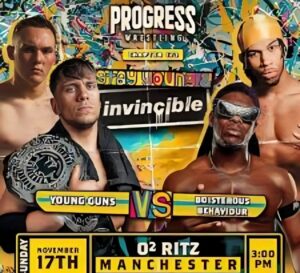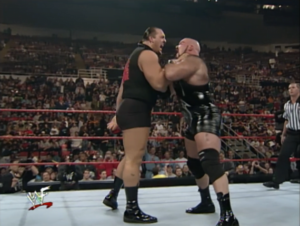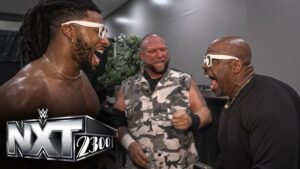Australia and New Zealand have always managed to be prevalent forces in world sport. Whether it is the Australian’s dominating World Cricket from the Mid Nineties to the 2007 Ashes Series, or the Kiwi’s dominating rugby under Graham Henry’s regime. The Australasian countries have always been in the forefront of athletic competitions. Whilst they mostly dominate sports independently, they have seemingly joined forces to lead to a new wave of athletic dominance, and that is in professional wrestling. On the heels of Jay White’s challenge to Hiroshi Tanahashi at Wrestle Kingdom 12, we take a look at the history of Australian and New Zealand pro-wrestling and try to pinpoint why the sport is seeing an increase in popularity and how young Australian and New Zealand wrestlers are capitalising on this increased notoriety.
Working Class Strongman: The Beginning of the Rise of Pro Wrestling in Australasia

The rise of professional wrestling in Australasia began in the early 1900’s and is often signified by legendary grappler Georg Hackenschmidt’s early tours to the islands during that period. The slow rise of pro wrestling led to the NWA establishing the NWA New Zealand Heavyweight Championship, which although first won by Gisborne Katene, is credited to Maori wrestler Ike Robin as its first champion. Australia would not have an NWA belt until 1938 when Lofty Blomfield won a championship tournament to be recognised as the NWA Australasian Heavyweight Champion. Whilst it took a considerable amount of time to establish a large Fanbase, wrestling in both countries gain popularity during the depression era of the mid 1920’s to around the start of the Second World War. One of the most famous matches to have occurred during that era were between the aforementioned Ike Robin and Polish Strongman Stanislaus Zbyszko in the Auckland Town Hall, which are noted for lasting several hours and with both men considered two of the most legitimate shooters of that era.

Through each countries association with the NWA, major wrestling names would regularly tour Australia and New Zealand during the 30’s and 40’s. During this period, the first ever champion first champion match in wrestling was once slated to occur in New Zealand when New Zealand’s Heavyweight Champion Lofty Blomfield was set to face off with NWA Heavyweight Champion Bronko Nagurski. It was slated to be a spectacle so grandiose that NWA promoter and legendary wrestler Toots Mondt was scheduled to appear. However, New Zealand was deprived of the match when Bronko cancelled his trip at the last minute, and the match would ultimately occur in Canada and be fought to a time limit draw. Never the less, established names still toured that country during this time, where the likes of Gorgeous George, Karl Gotch and Lou Thesz all completed tours to the countries.

During the 70’s, Kerry Packer’s Nine Network ran a program called WCW Australia, becoming the only major promotion in Australia until Andrew McManus’ WWAS started in the embers of a dead WCW in 2001. Wrestlers including the Brisco Brothers (Jack & Jerry), Andre the Giant, Ric Flair and Abdullah the Butcher all appeared in its programming that ran middays on Saturday’s and Sundays. This continued until 1978, when the rise of Kerry Packer’s World Series cricket caused the program to cease in 1978. This led to a decline in wrestling in the countries as there was not a major promotion or territory that ran significant shows in the countries.

During this period, Australia and New Zealand were known for producing some of the most well renowned wrestlers in the world. Pat O’Connor, a former Commonwealth games freestyle wrestler became an NWA world Champion by defeating Dick Hutton in 1959. Although not a kiwi, Peter Maivia (father to The Rock) was a major star in New Zealand, winning their Heavyweight title on multiple occasions. Other famous wrestlers from this era included Austra-Greek wrestler Spiros Arion, Italian strongman Mario Milano, The Australians Tag Team Ron Miller and Larry O’Dea and Memphis legend Bill Dundee.

It’s easy to understand why wrestling was popular during this period; Australians were attracted to the tough man. Our culture was based around hardship and how manly you were. When you see a Spiros Arion or a Lofty Blomfield, you see a working class, tough as nails ‘bloke’ Aussies and Kiwis wanted to root for the guy that epitomised what they perceived the Australian man to be. A blue collared form of entertainment, people related to wrestling and the wrestlers themselves. Whilst the modern market is booming, you can pinpoint the 30’s and 50’s as being the best time for New Zealand wrestling and the 60’s and 70’s as the best time for Australian wrestling, and once the wrestling industry started to reach a mainstream audience, The appeal of wrestling in Australia withered.
The Popularisation of Mainstream Wrestling and Its effects on the Australasian Market

The 80’s and 90’s, although a great time for wrestling business as a whole, had a damaging effect on the Australian market. A Once lucrative pay day ad turnt to an inconvenient location as wrestling’s popularity boomed with the rise of Jim Crockett, WCW and the WWF during this time whilst wrestlers such as the Bushwhackers, Outback Jack and Bill Dundee working primarily in the US as there were more opportunities forthcoming. The move towards a more family orientated, outlandish style of wrestling was the reason that Australian’s lost interest. Even with Superstars of Wrestling and Saturday Night’s Main Event airing on channel Nine, people simply didn’t care about wrestling anymore.

The industry had become even more obsolete in New Zealand due to the closure of All-Star Pro Wrestling, a company that had been running strong in New Zealand for over 30 years, in the early 1990’s. Whilst New Zealander and former All-Star Pro Wrestling promoter Steve Rickard served a brief tenure as the president of the NWA, New Zealand had an extremely limited presence in the wrestling industry by the turn on the 21st century. There first foray back into professional wrestling was at a World Wrestling All Stars show in Auckland New Zealand in 2003, where Jeff Jarrett defeating Sting to unify the NWA World Heavyweight title with the WWA World Heavyweight title. From here, numerous promotions arose, from Impact Pro Wrestling, New Zealand Pro Wrestling and Mania Pro Wrestling. Prominent names to appear from these promotions include current New Japan Young Lion Aaron Henry, NXT development wrestler Dakota Kai, prominent Indie worker Britenay and current Progress Champion Travis Banks.
https://www.youtube.com/watch?v=ciVXyS_a3lY
Australia’s last two attempt to establish a major wrestling promotion came in the form if Andrew McManus’s vanity project and the previously mentioned World Wrestling All Stars, and with the Dennis Rodman promoted I-Generation Superstars of wrestling. Created in the embers of the demise of WCW, Andrew McManus initially wanted his promotion to be a legit competitor to WWE. To do this, he hired Vince Russo to book his shows with major stars like Bret Hart, Jeff Jarrett, Konnan and Sting appearing in the promotion. While Vince Russo never actually wrote for the promotion, the promotion still came across as a cheap WCW knockoff and it was never taken seriously as a threat. Whilst it attempted to push Australian Nathan Jones and youngsters like AJ Styles and Low Ki, it was never able to catch fire. I generation on the otherhand came across as nothing more than a publicity stunt, with a sense of mediocre lingering over the show. From average mentions, substandard quality to a bad main event with Rodman and Curt Hening, it never became an ongoing promotion and only ever made one show.
A major factor to the loss of interest in pro-wrestling in Australasia, besides the move away from its presentation of blue collared strongman, is that every attempt to start a major promotion came across as a joke. With the monumental failure of WWAS and I-Generation damaging the drawing power of Australian and New Zealand wrestling, the scene has suffered tremendous. With this in mind, the scene is seeing a surge in prominence due to the influx of talented workers into the major systems.
An Increased Presence: The Return of Australasian Wrestling.

The last 7 to 8 years have been a great move forward in the prominence of Australian pro-wrestling. This moment was spearheaded by the recently released Emma, who gain a reputation as a promising talent before signing with the WWE in 2011. She was one of the prominent women responsible for the push of serious womens wrestling. Her work in NXT, along with her matches with Paige for the first NXT championship, was influential in the WWE scraping the Divas tag. Whilst her main roster run was marred by inconsistent booking, injuries and Emmalina, her role in the current state of both womens wrestling and Australasian wrestling is undeniable.

Whilst Emma has been a key figure in modern womens wrestling, another reason that the Australasian scene is heating up is due mainly to Melbourne Championship Wrestling. Based in Essendon, MCW has been a key influential with the increased awareness of the Australian Indie show. Besides being arguable the best wrestling show in the southern hemisphere, they have been one of the best presenters of womens wrestling in the world. With the likes of Emma, Billie Kay, Peyton Royce, Shazza McKenzie, Demi Bennett, Toni Storm and Evie (aka Dakota Kai) passing through the system, they have constantly proven their ability to present womens wrestling properly. Coupled with this, they have produced Cruiserweight Classic participant Damien Slater and current PWG talent Jonah Rock. With Will Ospreay recently moving to Australia and MCW to increase its prominence, MCW is quickly become one of the superior wrestling promotions around the world, and their upcoming show November Rain featuring IWGP Heavyweight Champion Kazuchika Okada gratifies the hard work they have put in in raising the prominence of Australian wrestling

Whilst not as hot as the Australian scene, New Zealanders have had a key role in modern pro wrestling. Jay White’s prominent role at Wrestle Kingdom 12 against Hiroshi Tanahashi shows us that Kiwis are able to produce top quality wrestlers. Other New Zealanders that are currently doing well on the indie scene include Progress Champion Travis Banks, British born Stardom and Rev Pro wrestler Bea Priestly, NXT signee Evie and prominent indie faction South Pacific Power Trip. Tongan wrestler Bad Luck Fale promoted a major show in 2016 which saw The Elite face Chaos in a six man tag main event that served as a precursor to the epic Okada/Omega rivalry of 2017. With this is mind, we can see that there is a renewed interest in New Zealand pro wrestling.
Future Shock: What Does The Future Hold for Australasian Wrestling?

Promotions in Australasia have a great chance to catapult themselves into being major independent promotions in the ilk of an ICW or a Rev Pro. With enough talented and prevalent wrestlers on the current indie scene and in the WWE/NJPW system, there is a feeling of optimism in Australasian pro-wrestling. With the likes of Tommy Dreamer and Will Ospreay making concerted efforts to promote the Australian scene, promoters need to capitalise on the increase exposure. If we are presenting a scene that major names within pro wrestling want to experience, that is only a good sign as it needs to more work for indie wrestlers around the world.





![The Rock Says... Too Much: Overshares in GQ and The Rise of All Access Fans [Photo Cred: GQ/Eli Russell Linnetz]](https://lastwordonsports.com/prowrestling/wp-content/uploads/sites/15/2024/11/gq_dwayne-johnson-gqs-men-of-the-year-interview-300x169.jpg)
